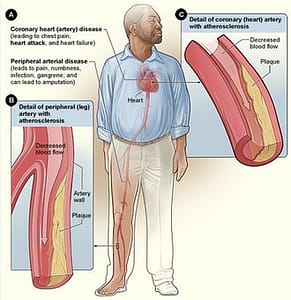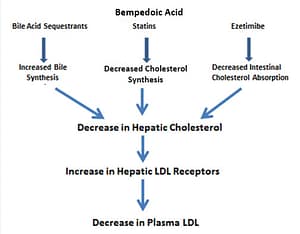- An ApoB cholesterol test can help identify your risk for heart disease.
- The test is not on standardized lipid panel testing that doctors typically perform at annual exams.
- “Good” and “bad” cholesterol still matter for heart health, but understanding ApoB levels can give clinicians more information to work with.
You’ve most likely heard of HDL (“good”) and LDL (“bad”) cholesterol.
The U.S. Centers for Disease Control and Prevention (CDC) describes each as the following:
- High-density lipoprotein (HDL) cholesterol can decrease the risk for heart disease and stroke because it carries cholesterol to the liver, which removes it from the body.
- Low-density lipoprotein (LDL) cholesterol makes up most of the cholesterol in the body. Having high LDL cholesterol raises the risk for heart disease and stroke because it builds up as plaque on the walls of your blood vessels, which can lead to heart disease and stroke.
HDL and LDL cholesterol are often measured based on a blood draw and standard lipid panel test taken during an annual exam at the doctor’s office. The panel also measures total cholesterol and triglycerides, a type of fat in the blood that can raise risks for heart disease and stroke.
Doctors are mostly looking for “bad” cholesterol levels detected on the panel.
However, do we know that Apolipoprotein B (ApoB) is the main protein found in LDL cholesterol and can be tested, too?
The LDL cholesterol value you get from the doctor is actually a calculated estimate of the concentration of LDL particles in the bloodstream, but the ApoB number is a direct measure of all the particles that could contribute to cardiovascular disease in our bloodstream.
What is ApoB?
Dr. Salim Virani, a cardiologist at The Texas Heart Institute and the Aga Khan University, explained that cholesterol is carried in LDL, very-low-density lipoproteins (VLDL), intermediate-density lipoproteins (IDL), and lipoprotein(a) particles.
Each of those particles has a protein attached to it and the protein is ApoB.
ApoB protein moves fat throughout the body and helps it to get through the walls of arteries, where they form plaque. When this happens, it increases the risk of heart disease and stroke.
There are 2 types of ApoB: ApoB 100 and ApoB 48. ApoB 48 is made in the intestine and is usually found on chylomicrons and ApoB 100 is made in the liver. ApoB100 us the most important when it comes to atherosclerosis. ApoB 48 is called this because it is 48% of the molecular mass of ApoB 100.
- Any particle that has an ApoB molecule attached to it has the potential to end up in the artery wall and cause atherosclerosis.
- ApoB is proportional to the number of atherogenic particles.
There is no need to do expensise nuclear magnetic resonance tests to assess your particle count. There is only 1 ApoB molecule per particle so the ApoB measurement is basically proportional with the number of atherogenic particles in your blood. The most abundant ApoB particle is LDL.Therefore your plasma ApoB number represents all the particles in your blood that can cause atherosclerosis.
“We still need to do a better job of explaining to patients what good cholesterol and bad cholesterol are. After that, if you have a patient who is very interested in knowing more about their risk of heart disease pertaining to cholesterol, then you can make the transition to the next level and get into explaining to them fully what ApoB particle concentration is and how it is different from the usual LDL cholesterol that we measure on a standard lipid panel,” Virani told.
Why Might apoB Be a Better Predictor of Heart Disease Risk?
A standard lipid panel generally includes four things: total cholesterol, high density lipoprotein (HDL) cholesterol, LDL cholesterol, and triglycerides. The cholesterol carried in plasma is a mix of other lipoproteins, many of which do not have an association with heart disease.
While LDL levels can indicate heart disease risks, they’re not always consistent because they can vary in size and density. But every LDL particle carries exactly one molecule of apoB, making apoB a more accurate predictor of heart disease risks.
ApoB is a more powerful predictor of the risk of heart disease and stroke than LDL-C1 . A Recent meta-analysis of over 233000 people showed that ApoB was the most powerful predictor of risk of cardiovascular disease, followed by Non HDL-C and then LDL-C.
Your ApoB number should be central to assessing your risk of heart disease and stroke.

What are the main causes of atherosclerosis?
There is never one single cause of atherosclerosis. The process of atherosclerosis involves damage to the arteries, ingress of ApoB particles into the artery wall followed by macrophages and an inflammatory process. Modifiable risk factors are risk factors that you can potentially change to manage your risk. Male sex is a risk factor but it is not modifiable.
The 3 main modifiable risk factors for atherosclerosis are:
- Smoking
- High blood pressure
- ApoB particles
The amount of atherosclerosis you develop is proportional to the concentration of ApoB particles in the blood and the duration of exposure of the artery walls to the ApoB particles.
Who should get their ApoB levels tested?
LDL cholesterol that is measured on a standardized lipid panel shows how much cholesterol is carried in a person’s LDL particles, and for the most part, is a good measure of cholesterol-associated risk, said Virani.
However, tests for ApoB levels have been around for over a decade and are becoming more standardized in recent years, he said.
“I think sometimes knowing ApoB is more important for clinicians who need information beyond just regular cholesterol that they measure with the lipid panel and there is a subset of patients where it might be more useful,” Virani said.
While apoB is not included in a standard lipid panel test, it’s a good idea to have your apoB levels measured at least once to see if it’s consistent with your cholesterol levels, especially if you have a family history of heart disease.Individuals with insulin resistance, type 2 diabetes, obesity, elevated triglycerides, or metabolic syndrome are particularly at risk for heart disease, and they should be more concerned about their apoB levels.
For instance, he said patients who are obese, have high triglycerides, or who have metabolic syndrome (low HDL cholesterol and high triglycerides) may benefit from ApoB testing.
“In those cases, LDL cholesterol — what we have traditionally measured — may not be the perfect marker in terms of letting a clinician and patient know what their risk is related to cholesterol, and in those cases, measuring ApoB could be helpful in deciding what kind of therapies to use on the patient,” Virani said.
Dr. Deehan noted that ApoB should be a complement, rather than a replacement for HDL cholesterol, LDL cholesterol, and non-HDL cholesterol values.
“They have been studied for decades, and there is a large body of knowledge linking them to disease risk that is valuable context to have. Plus, clinicians have been working with these numbers for decades, and are comfortable with them,” she said.
Moreover, some providers might prefer to calculate ApoB levels on their own without an additional test, said Virani. They do this by looking at the lipid panel results and calculating the non-HDL cholesterol number by subtracting good cholesterol from total cholesterol. Whatever number is left signifies the value for overall bad cholesterol.
Deehan added that while ApoB and LDL values are often highly correlated, discordance is possible. For example, she explained that moderately elevated levels of LDL and elevated ApoB levels may cause concern compared to someone with the same elevated LDL but optimal levels of ApoB.
“There is evidence that cardiovascular risk better follows your ApoB levels than other common lipid metrics,” she said. “This additional context matters, and allows clinicians and researchers to better understand the contributors to cardiac disease risk in a more refined way.
How to measure ApoB
ApoB in the blood is a simple and cheap blood test. The result is given in either mg/dl or g/l. The mg/sl number is 100X that of the g/l. e.g. 1.06 g/l = 106 mg/dl
What is an optimal ApoB level?
For ApoB the lower the better. If you want to lower your risk the most you should be trying to get your ApoB below 60mg/dl.
When should I start lowering my ApoB?
Atherosclerosis is driven by the concentration of ApoB particles in the blood and the duration of exposure of the arteries to ApoB particles. We also know from autopsy studies in road traffic accident victims that atherosclerosis starts when you are young. Think in your teens or 20s! Therefore, if you want to lower your risk of cardiovascular disease, the earlier you start lowering your ApoB the better.
How can I lower ApoB?
ApoB can be lowered with certain lifestyle changes, but the most powerful method of lowering is with medication.
How can I lower ApoB with lifestyle?
The same measures that lower LDL-C, will also lower ApoB
- Reduce saturated fat
- Increased fibre
- Increased poly and mono unsaturated fats
- Reduce trans-fats
How can I lower ApoB with medication?

Using medications is the most powerful way to lower your ApoB. Depending on how high your ApoB is to start with you may need a combination of therapies. Most of these medications increase the activity of LDL-receptors in the liver. LDL receptors pull ApoB particles out of the circulation.
- Statins – These drugs inhibit the enzyme HMG CoA reductase, this reduces the production of cholesterol in the liver. The liver then starts to pull ApoB lipoproteins (mainly LDL particles) out of the blood and also reduces the number of ApoB particles it produces.
- Ezetimibe – This blocks the reabsorption of cholesterol in the intestine which then increases LDL receptor mediated uptake of ApoB particles by the liver. This drug is particularly effective in patients that are hyper-absorbers of cholesterol.
- PCSK9 inhibitors – A very powerful antibody injection that increases uptake of ApoB particles by the liver. You need to take the injection once every 2-4 weeks.
- Inclisiran – A new drug that is injected once every 6 months! It is a small interfering RNA drug that increases the activity of the LDL-receptors in the liver and lowers ApoB.
Conclusion
If you want to lower your risk of heart disease and stroke, you need to know your ApoB and lower it. It is a cheap and simple test and should be the focus of your longevity strategies. Most people will need some form of medication to get it to very low levels.






